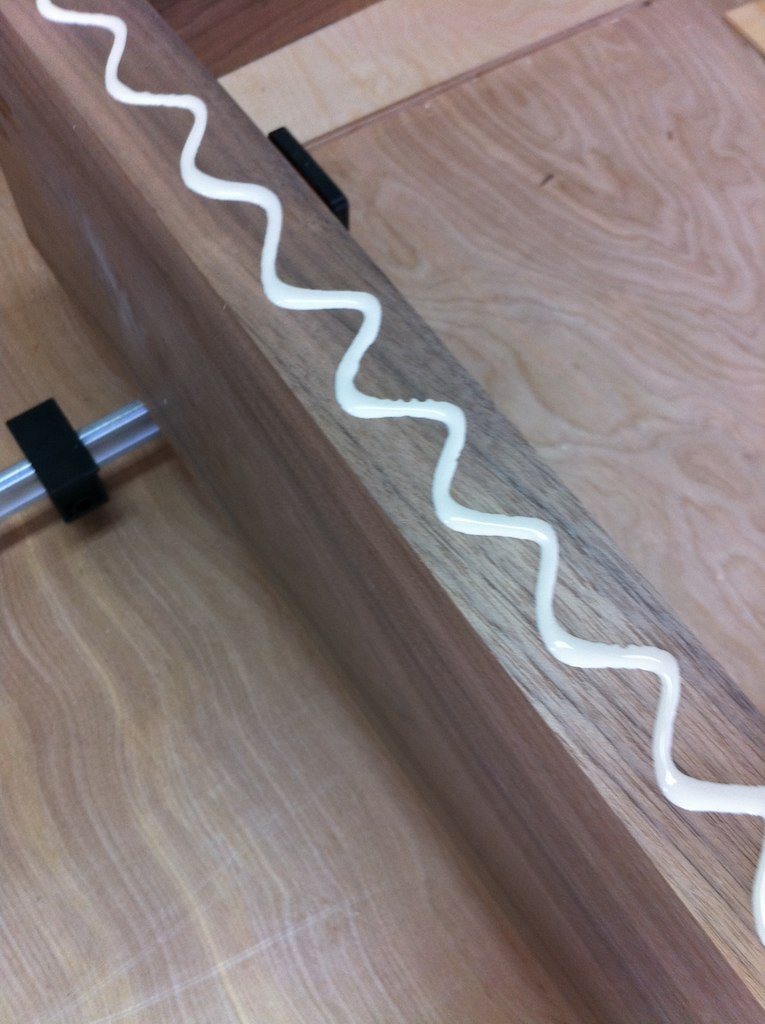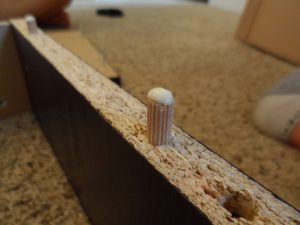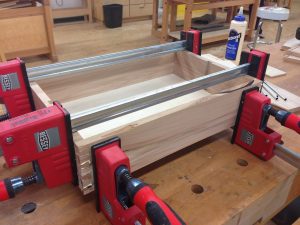Adhesives play an essential part in woodworking. Bonds are one of the most common materials of all joinery materials and techniques. While other materials such as nails and screws are in, especially for building buildings, adhesives provide superior bonding and the advantage of not leaving any hole behind or hardware visible.
Various types of glue have been used in woodworking throughout the years, almost all of which are still available today. But PVA glues have become the number one choice for woodworking and arts and crafts due mainly to their availability, price, and ease of use.
So Just what is PVA Glue?
The term “PVA” stands for polyvinyl acetate, a member of the polyvinyl esters family, and refers to a variety of different glues which are all similar. This includes wood glue, white glue, school glue, and carpenter’s glue. These glues’ differences are minor but can affect how they work.
Looking at it another way, PVA wood glues are thermoplastic suspended in water when the water evaporates away.
It leaves the plastic, the molecules that are joined to stick together and have entered the pores of the wood, paper, or other material, creating a solid, strong bond.
Different PVA adhesives will have slightly different properties. The differences between white and yellow PVA glues are probably the most notable. White PVA glue, such as school glue, is not waterproof and can be weakened over time and yellow. Yellow PVA glue is water resistant, although not waterproof (it can’t be immersed), so moisture does not affect it. However, yellow PVA glue is more expensive than white school glue, which is why white glue is used for craft projects and arts and crafts in the classroom.
Part of the motivation for creating PVA wood glue glues came from the difficulty in working with hide glue, which was the everyday glue in use for woodworking in the years before PVA wood glue glues existed. Hide wood glue needs to be heated in preparation for service and use. It also produces an odor that some people find objectionable.
On the other hand, PVA wood glue can be used at room temperature and is odorless. On the other hand, hide glue can be removed by heating, which doesn’t work for applying PVA wood glue.
Unlike epoxy, which is set by a chemical reaction, PVA glues are formed by evaporation. Polyurethane adhesives, like Gorilla Glue, and Cyanoacrylate glues, like Super Glue, also cure by a chemical reaction.
Still, in the case of these adhesives, moisture triggers the chemical reaction, not something contained in the bond itself. This means shrinkage can be more of an issue with PVA glues than others. Where high gap filling is necessary, PVA glues are not the best choice, as they are not a high solids adhesive.
However, the PVA adhesive is water soluble, making it possible to clean it up with water. Adding water to the glue and thinning it out is helpful in some situations and with some materials, although not usually with porous materials such as paper, cloth, or wood.
Adding water can also salvage old glue thickened in the glue bottle. In either case, add small amounts of water at a time, stirring each time more water is added until the desired consistency is reached.
Please note that because PVA glues are water-soluble, they can be cleaned out of clothing or carpeting as long as they are wet. Once dry, cleaning them out requires soaking the fabric for an extended time to soften the PVA glue paper and cloth, then scrubbing the glue paper, the material, and the cloth with a stiff nylon brush to break it up.
Once dry, wood PVA glue is both strong and flexible. The typical tensile strength for wood PVA glue is 3,750 PSI, roughly half that of epoxy. However, in any properly glued joint, the bond between wood PVA glue tips is likelier to break than the bond between these adhesives.
Disadvantages of PVA Glue
While PVA adhesives are excellent, they are not without their failings. For most of us in school who use PVA glue and most of our projects, these failings are minor enough not to be necessary. Even so, we need to be aware of them so that we don’t expect something of the glue that it can’t deliver.
First, waterproof PVA glue is water-based, so it should not be allowed to freeze. Freezing breaks up strong bonds in the polymer (a string of the same kind of molecules), destroying the glue’s ability to stick. Allowing the water to evaporate or moisture to get out of the PVA glue, either through it sitting too long or the lid being left off the container, renders the glue useless.
While PVA adhesives do dry thoroughly, it takes 24 hours. This isn’t very clear to some people, because the working time is a mere 3 to 5 minutes short.
But complete curing requires all the water to evaporate out. While this might happen quickly on the surface tacky glue, cutting short the working time, it takes considerably longer for the water-resistant moisture inside the tacky glue to work out into the air.
Some algae, bacteria, fungi, lichens, and yeasts can break down PVA adhesives, degrading their holding power; however, I have never had this happen with any of the porous adhesive’ materials in my projects.
PVA Glue and Finishes
Care must be taken when using PVA or water-resistant glue to prevent it from getting on finished surfaces. Some people say that PVA water-resistant glue should not be used when the project is varnished.
This comes from the problem that using PVA glue causes stains and varnishes in that it fills the pores on the surface of the wood and skins over the top. When pigments or varnish are applied over this, it makes for a splotchy finish.
Some people say that the solution to this problem is to wipe the glue off with a damp cloth or paper towel. This will eliminate any excess adhesive sitting on the surface but will not do anything to remove the glue that has made its way into the wood’s pores.
Others say the best thing to do is to allow the glue to bead up and then remove it with a chisel once it is dry.
This works better, especially in cases where there is only a tiny amount of glue. However, it is not a foolproof solution, as the area under the beaded-up glue will still be problematic. That glue must be sanded off to access bare wood for finishing.
Of course, this isn’t an issue for exterior projects with opaque finishes or porous materials such as paint. When in doubt, do a test piece before assembling the project to see how the glue might affect the finish.
Preventing Glue Squeeze Out
The best solution is not to get water-resistant glue on the finished surfaces. That can be challenging, especially since it is usually necessary to get the suitable adhesive onto the entire surface being joined together, that generally leads to some warm water from the glue squeezing out of the joint.
This can be prevented during the gluing process. One key is to learn just the right amount of glue to use for various types of joints, applying what’s needed and no more. Holding back the adhesive just slightly from the edge, such as in a miter joint, also helps as the glue squeezing out has a place to go.
Finally, in more complex cases, such as when putting a mortise and tenon joint together, bring the joint most of the way together and then stop to wipe the excess glue out of cracks in the joint with a toothpick before closing the joint all the way.
Planning for Squeeze Out
Another option is to plan for the potential of glue squeezing out by partially finishing the pieces before assembly. Suppose a project is to be stained and varnished. Applying the thin coat of stain and brushing over the first coat of varnish before the body can be more accessible.
Then, when the project is assembled, any glue that squeezes out is going to be on top of that first layer of varnish, where it can be cleaned off, either with a damp cloth or a chisel, leaving a surface that can accept additional layers of varnish, without staining.
Using PVA Over Existing Finish
This raises another question – can PVA adhesives be used over finishes, such as varnish or paint? The answer to this is yes… and no. It’s a yes because the adhesive will bond to those surfaces, allowing things to be glued together.
But at the same time, the no comes because the cement and resulting glue joint will not be anywhere near as strong as what would typically be expected. Chances are that if the glue joint were put under pressure, it would collapse.
Part of most adhesives’ work requires getting a good “bite” on the material surface. In the case of wood glue, this is provided by the pores in the porous surfaces of the wood.
We can’t see it, but a small amount of the glue oozes into those pores, so when the glue dries, there are continuous strings of polymer from inside the pores out to the rest of the joint. That’s an essential part of what provides the strength. When finished, block those pores. The glue joint is not as strong.
One thing that can be done in these cases is to rough up the finished surface with medium to coarse grit sandpaper, providing scratch lines for wood adhesive and the wood glue itself to “bite” into.
The used paper, the wood glue, the wood adhesive, and the resulting scratches should be limited only to the area that will be glued so as not to mess up the piece’s finish.

Using PVA glue, Rob Cameron
Using PVA Glue
As with any adhesive, proper surface preparation is essential for applying PVA glue. That means having a clean, flat, oil-free surface. use PVA glue has minimal gap-filling capability, so the characters to be glued together must fit together cleanly and snugly. If there are any gaps, the parts must be sanded to eliminate them, or another adhesive should be used.
If the surfaces fit together well, but porous surfaces are incredibly smooth and porous surfaces non-porous, it can help to have sanded them slightly with coarse sandpaper to ensure that the glue has something to bite onto.
Then remove all sawdust from the surfaces to ensure that the sawdust doesn’t get in the way of the parts coming fully together.
Always take the time to dry-clamp the project together before gluing it, and use PVA glue. PVA glues only have a 3 to 5-minute working time, so clamping the project together quickly is essential.
Dry clamping provides the opportunity to ensure that everything fits, there are enough clamps available, and that there aren’t any unforeseen problems clamping the parts together.
Cauls may be needed in some cases, such as when laminating a tabletop or gluing curved pieces together.
Apply the glue to one of the surfaces to be joined together. Glue bottles come with a nozzle to make them more accessible, and it is, in most cases.
But there may be times when large areas must be glued together, where the nozzle is not an advantage. In those cases, pouring the glue onto the surface or working out of a cup could be better. The glue can be spread:
- With a finger, the best glue spreader there is
- With a plastic glue spreader
- With a paintbrush (great for large areas)
- With a paper towel or rag (although this wastes a lot of glue)
Press the surfaces to be glued together and clamp them. Enough clamping force must force the parts to bond, closing the gap between them.
Allowing some squeeze out of the g clamp can prove that the details are as tightly clamped as possible. Don’t over-tighten g clamp, as that can damage the wood or cause warping of the wood and project.
Allow the project to sit for 24 hours to dry before removing the paper adhesive from the wood clamp.
Chip off any glue bead that squeezed trapped air out of cracks in the joint with a sharp bench chisel and sand the joint smoothly.
Finish the project.



